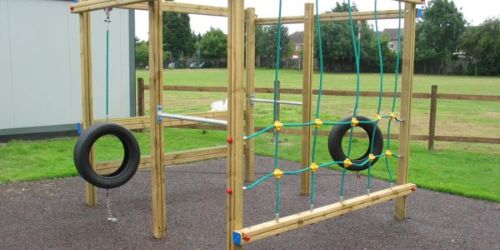Outdoor play areas have had a magnetic attraction for generations of children, compelling them to play outside. This is even more critical for mental and physical development with all the technology and screens available 24/7 in the modern world. As a result, childhood development is advanced when they play outdoors, both mentally and physically, while also helping them develop social skills and learn about the outside world. Most schools have play equipment and climbing frames that children can use at recess and lunch.
It helps children to get out and play between classes, preparing their minds for the next session. But when it’s time to change or get a piece of new play equipment or a climbing frame set, where can you start? Which is best to choose? It can seem like an overwhelming proposition, but fear not; with a few considerations, it will be easy and straightforward. We’ve added some ideas below to get you started on selecting the best climbing frame for your school and students.
#1. Look For High Quality
A new climbing frame will be a feature in your school playground; over time, it will be used plenty, taking on a pile of wear and tear. If you select a low-quality frame at the start, it will age fast, and issues will show up quickly on the equipment. These effects can be very serious and rapid and will cause the structure to need repair or replacement sooner than you would like or may have budgeted for. Regular maintenance can cost both time and money, often more in the long run than if you had paid more for a better set in the first place.
Therefore, it’s important to ensure you go for a high-quality frame that will withstand heavy usage from the tart. Sound quality will be easy to maintain and won’t be damaged easily, meaning less cost and fuss on an ongoing basis. This consideration also needs to include weather resistance capabilities that include wind, rain, and storms. Quality equipment should not be damaged by inclement weather. Choosing a long-lasting material such as wood can really make all the difference to your equipment’s longevity and staying power for years to come.
#2. Choose the Right Frame for Your Children’s Age
When choosing a climbing frame, you need to consider the age of the children that will use it. In particular, how old they are and their average size can be tailored accordingly. For example, a frame will need to be a different size and placement for an early years group compared to bigger children with longer limbs and reach. This consideration needs to include additional components such as swings, slides, and monkey bars, which all must be age and size appropriate. Many climbing frames are designed to be suitable for multiple age groups, so planning for your specific school will help with the selection, and it will be useful if there are different parts for different ages, so that you can pick the right ones.
The last thing you’ll want after having gone to the trouble of selecting new play equipment is to discover it’s unsafe or unfit for purpose due to sizing.
#3. Plan For Multiples
Any frame you choose also needs to be able to accommodate multiple children at once in safety. With low impulse control and the natural child’s desire to run free and have fun, there may be a flurry of activity in the playground on breaks. More than one pupil will want to climb on the equipment when they see their friends and classmates climbing too. Supervisors often struggle to regulate how many children use a piece of equipment all at once, so safety in selection helps negate that issue right from the start.
Knowing the approximate number of children that may use the equipment ahead of time makes a difference. You can then plan for the required sturdiness of equipment required means you can plan and purchase a strong-quality frame accordingly.
#4. Consider Size and Placement
Another essential consideration is the measurements of your outdoor area and how the frame can fit into it. Any climbing frame must be set in a large enough outdoor setting to provide a margin around the perimeter. This has a few reasons. First, this will provide space for children to get on and off safely, free from catching themselves on other equipment or fencing. The ground must also be leveled so the frame can be appropriately placed. If the surface is uneven, the equipment will be too, causing a hazard that could include the entire frame tipping and causing injuries.
Another safety consideration is a margin of space around the frame in the event of a fall. If any other equipment or fencing is too close, it can cause a severe health hazard in the event of a fall. The surrounding area, too, should be prepared with sand, wood chips, or grass to take any fall impact should a child climbing take a tumble. And lastly, the entire frame needs to be fitted by professionals who guarantee their work. This professional approach will also offer the school staff and the pupil’s parents peace of mind.
#5. Professional Guidance Needs To Be a Priority
Playgrounds and play equipment are a wonderful part of childhood and a memorable element of school. They are also a fantastic way to encourage active and healthy activity for children, getting fresh air and keeping their energy levels up between classes. But, as mentioned, when it comes to safety, there is more to it than simply choosing the best playground equipment – there is a process to getting everything safe and in place.
To obtain guidance and ensure everything is done right from the start, speak to a professional before making any decisions on your site and setup. A playground professional will assist in selecting your best possible equipment, budgeting, and installing your climbing frame with every safety consideration and assessment. This professional help and consultation will pay by saving time and money in the long run with low maintenance costs and a frame that will last for many school years to come.






